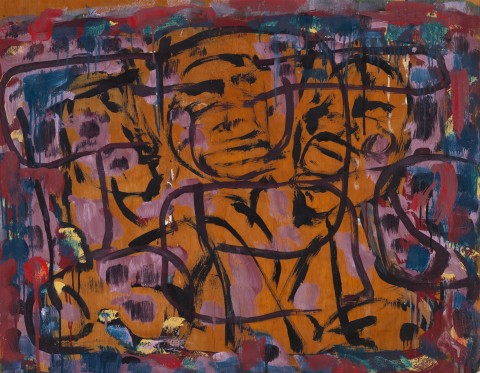THREE FACES, c.1965
IAN FAIRWEATHER
synthetic polymer paint and gouache on plywood on board
61.5 x 80.0 cm
bears verso certificate of authenticity signed by Mary Turner, Director of Macquarie Galleries, dated 30 January 1976
Macquarie Galleries, Sydney, 1965 (label attached verso)
Dr Mary Beeston, New York, USA
Sotheby’s, Melbourne, 30 April 2002, lot 64 (as ‘Untitled Abstract’)
The Cbus Collection of Australian Art, Melbourne, acquired from the above
on long term loan to Wollongong City Gallery, New South Wales
Nainby, B., Stanhope, Z., and Furlonger, K., The Cbus Collection of Australian Art, in association with Latrobe Regional Gallery, Melbourne, 2009, pp. 106 (illus.), 218
From his emergence in the 1930s as a precocious modern painter, through to late career deference in the 60s, Fairweather’s interest in faces and figure groups holds an enduring presence. Individual faces, pairs and groups occur in works from each decade – mother and child is another recurring theme. One is usually unaware of the subjects’ individual identities, although Three Faces, c.1965 shares something of the loosely contained geometry of Portrait of the Artist, 1962 (National Gallery of Australia).1
A formative decade in Fairweather’s oeuvre, the thirties were strong in French Post-Impressionist mannerisms and soft chalky tones and surfaces. Yet if the present work bears the familiar dryness and painterly drawing, that is where stylistic similarities end. His interest in Asia – and China in particular – became an intellectual and expressive enchantment. Indeed, Three Faces is something akin to a bookend after decades of close, contained portraits consumed his interest. Faces at the Window, 1933 (Queensland Art Gallery ǀ Gallery of Modern Art) is an early indicator of this preoccupation.2 Other important moments flank 30 years of unwavering critical interest in his work. The Tate acquired his work in 1935, while in 1965, Fairweather’s retrospective exhibition toured nationally, and his book, was The Drunken Buddha, published.3
From 1953, he lived in his now legendary improvised and rough-hewn circumstances on Bribie Island, an hour north of Brisbane. Much too has been made of his boundless curiosity, travel in Asia and (mis)adventures. Periods of depression and paranoia didn’t diminish his capacity for productive work, producing paintings which were to define him as one of Australia’s greatest modernists. In the 1950s, Cubism as a compositional and pictorial underpinning was finally overtaken by his confidence to apply what he had learnt and absorbed from Chinese painting – an intense preoccupation which was no mere encounter and something expediently adapted, but rather a culture whose art and language he understood with scholarly nuance.
In Three Faces, lines are single gestures, marks and flecks are ‘placed’ and never vigorously worked; Fairweather had observed Chinese calligraphers at work, ‘…calligraphy is at first a performance – it is a graphic dance, the dynamic trace of gesture, the translation into two-dimensional space of a fluid sequence of movements unfolding in time.’4 Similarly, the wooden panel support reminds us that Fairweather was untroubled by using whatever was on hand. The wood retains holes and exposed areas revealing it was un-primed and it serves as a halftone for a muted, austere palette. A label notation on the reverse suggests that this work, with the agreement of the artist, was used by the Art Gallery of New South Wales conservation department to further understand the artist’s techniques in the future restoration of his work. Three Faces not only emanates a surface personality and character which mark his paintings from the 50s onwards, but its painterliness and painted lineal forms encapsulate his late figuration with familiar distinction.
1. Self Portrait, 1962, synthetic polymer paint, gouache on cardboard mounted on composition board (National Gallery of Australia) reproduced in Bail, M., Fairweather, Murdoch Books, Sydney, 2009, illus. p.191
2. Faces at the Window, 1933, oil gouache and pencil on paper on cardboard on composition board, (Queensland Art Gallery ǀ Gallery of Modern Art)
3. Fairweather, I., The Drunken Buddha, University of Queensland Press, Brisbane, 1965 (the publication is a translation of an ancient Chinese novel, illustrated with Fairweather’s paintings).
4. Ryckmans, P., ‘An Amateur Artist’ in Bail, M., Fairweather, Art and Australia Books in association with the Queensland Art Gallery, Brisbane, 1995, p. 15
DOUG HALL AM
